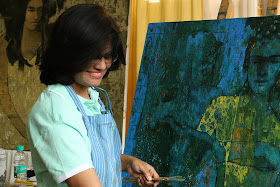BEING ‘HER’
She sits, crouched, pensive and lost in her thoughts or talks in hushed whispers to
her companions, almost inaudible, cocooned in her space. Swati Sabale’s present
body of paintings revolve around womanhood, a theme which the artist has been
preoccupied for a while now. In solitude or in groups, the women appear in varied
situations, offering a slice of their feminine world filled with its dichotomies of
strengths and insecurities, highs and lows, pleasures and pain, deference and
insinuations.
Swati fleshes out her characters from her surroundings, women on
board the Mumbai local train, or a remote hamlet near Pune, her relatives and
friends, her own journey into adulthood, encounters with the feminine gender
across multiple strata of Indian society, and even recent social and political events
that have made headlines.
The voluminous figures and heads are always encased in a painterly grid, which
the artist believes to play both formal and metaphorical role, providing for a
structure and representing the boundaries of the feminine domain. The woman is
constantly warned not to overstep these limits, though, in changing times, the
woman of today is ‘given’ more freedom. Drawn with an assured hand which
reflects Swati’s predilection for portraiture, the women with half closed eyes, and
drooping shoulders seem hesitant to share their very private world. She has the
fortitude to seek sustenance and joy within the limits of the demarcations,
balancing her multifarious roles as a wife, mother, daughter in a male chauvinist
society.
The artist prepares the canvas surfaces by dripping, dabbing, smearing and even
flinging analogues colour hues. The flow of acrylic colours, applied in diaphanous
overlays, augments in building up a sense of mystery and ambiguity. Questions are
raised in the viewer’s mind- Are these women happy? Are they content? What
exactly bothers them? For Swati, life is an enormous canvas of experiences which
are intertwined complicatedly, unpredictable and absurd, yet purposeful and
alluring and her paintings reflect these perspectives.
Dr. Manisha Patil
December
2017
Artist and Art Historian
Professor,
Art history
Sir. J.J. School of Art, Mumbai


